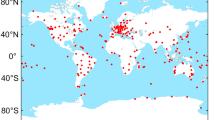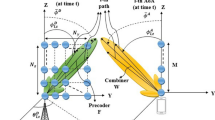Abstract
This paper deals with direction of arrival (DOA) estimation and blind signal separation (BSS) based on independent component analysis (ICA) with robust capabilities. An efficient demixing procedure of complex-valued ICA is presented here, which combines the signal-subspace demixing procedure exploiting individual signal-subspace projection and Newton’s iteration algorithm based on maximization of the approximate negentropy of non-Gaussian signal for array signal processing. It resolves the problems of order ambiguity and identifiability of traditional ICA for time-domain BSS. The proposed method could be directly applied to radar, sonar, radio surveillance, and communications systems for separating signals and estimating relative DOAs of signals. Several computer simulation examples for perturbations to the array manifold, unknown noise environments, and Rayleigh fading channel are provided to illustrate the effectiveness of the proposed method.
Similar content being viewed by others
References
Calros E., Takada J.I.(2003). ICA based blind source separation applied to radio surveillance. IEICE Transactions on Communications, E86-B(12):3491–3497
Toribio R., Saillard J., Pouliguen P. (2003) Identification of radar targets in resonance zone: E-pulse techniques. Journal of Electromagnetic Waves and Applications 17(12): 1723–1725
Liu H., Xu G. (1996). A subspace method for signature waveform estimation in synchronous CDMA systems. IEEE Transactions on Communications 44(10): 1346–1354
Kayhan A.S., Amin M.G. (2000). Spatial evolutionary spectrum for DOA estimation and blind signal separation. IEEE Transactions on Signal Processing 48(3): 791–798
Swindlehurst A.L., Kailath T. (1992). A performance analysis of subspace-based methods in the presence of model errors—Part I: The MUSIC algorithm. IEEE Transactions Signal Processing 40(7): 1758–1774
Ziskind I., Wax M. (1988). Maximum likelihood localization of multiple sources by alternating projection. IEEE Transactions on Acoustics, Speech, Signal Processing 36(10): 1553–1560
Viberg M., Swindlehurst A. L. (1994). Analysis of the combined effects of finite samples and model errors on array processing performance. IEEE Transactions on Signal Processing 42(11): 3073–3083
Jansson M., Swindlehurst A.L., Ottersten B. (1998). Weighted subspace fitting for general array error models. IEEE Transactions on Signal Processing 46(9): 2484–2498
Kangas A., Stoica P., Söderström T. (1994). Finite sample and modeling error effects on ESPRIT and MUSIC direction estimators. IEE Proceedings of Radar, Sonar, Navigation 141(5): 249–255
McCloud M.L., Scharf L.L. (2002). A new subspace identification algorithm for high-resolution DOA estimation. IEEE Transactions on Antennas Propagation 50(10): 1382–1390
Li J., Compton R.T. (1993). Maximum likelihood angle estimation for signals with known waveforms. IEEE Transactions on Signal Processing, 41(9): 2850–2862
Miller M.I., Fuhrmann D.R. (1990). Maximum-likelihood narrow-band direction finding and the EM algorithm. IEEE Transactions on Acoustics, Speech, Signal Processing 38(9): 1560–1577
Hyvärinen A., Oja E. (2000). Independent component analysis: Algorithms and applications. Neural Network, 2000 13(4): 411–430
Bell A.J., Sejnowski T.J. (1995). An information-maximization approach to blind separation and blind deconvolution. Neural Computations 7(6): 1129–1159
Cardos J.F. (1997). Infomax and maximum likelihood for blind source separation. IEEE Signal Processing Letters 4(4): 112–114
Pearlmutter B.A., Parra L.C. (1997). Maximum likelihood blind source separation: A context-sensitive generalization of ICA. Advances in Neural Information Processing Systems 9: 613–619
Hyvärinen A. (1999). The fixed-point algorithm and maximum likelihood estimation for independent component analysis. Neural Processing Letters 10(1): 1–5
Hyvärinen A. (1999). Fast and robust fixed-point algorithms for independent component analysis. IEEE Transactions on Neural Network 10(3): 626–634
Bingham E., Hyvärinen A. (2000). A fast fixed-point algorithm for independent component analysis of complex-valued signals. International Journal of Neural Systems 10(1): 1–8
Hyvärinen A., Oja E. (1997). A fast fixed-Point algorithm for independent component analysis. Neural Computations 9(7): 1483–1492
Saruwatari H., Kawamura T., Nishikawa T., Lee A., Shikano K. (2006). Blind source separation based on a fast-convergence algorithm combining ICA and beamforming. IEEE Transactions on Acoustics, Speech, Signal Processing 14(2): 666–678
Ikram, M. Z., & Morgan, D. R. (2000). A beamforming approach to permutation alignment for multichannel frequency-domain blind speech separation. In Proceedings of ICASSP, 2000 (pp. 881–884).
Davies M. (2004). Identifiability issues in noisy ICA. IEEE Signal Processing Letters 11(5): 470–473
Ikeda S., Toyama K. (2000). Independent component analysis for noisy data-MEG data analysis. Neural Network 13(10): 1063–1074
Wax M., Kailath T. (1985). Detection of signals by information theoretic criteria. IEEE Transactions on Acoustics, Speech, Signal Processing 33(2): 387–392
Yu K.B. (1991). Recursive updating the eigenvalue decomposition of a covariance matrix. IEEE Transactions Signal Processing 39(5): 1136–1145
Zha D., Qiu T. (2006). Underwater sources location in non-Gaussian impulsive noise environments. Digital Signal Processing 16(2): 49–163
Georgiou P.G., Tsakalides P., Kyriakakis C. (1999). Alpha-stable modeling of noise and robust time-delay estimation in the presence of impulsive noise. IEEE Transactions on Multimedia 1(3): 291–301
Kuruoglu, E. E. (1998). Signal processing in α-stable noise environments: A least l p norm approach. PHD Thesis, University of Cambridge, UK:Department of Engineering.
Chang A.C., Chiang C.T., Chen Y.H. (2000). An eigenanalysis interference canceler with robust capabilities. Microwave Optical Technology Letters 25(2): 100–103
Torrieri D., Bakhru K. (1997). The effects of nonuniform and correlated noise on superresolution algorithms. IEEE Transactions on Antennas Propagation 45(8): 1214–1218
Zheng Y.R., Xiao C. (2002). Improved models for the generation of multiple uncorrelated Rayleigh fading waveforms. IEEE Communications Letters 6(6): 256–258
Doob J.L. (1960). Stochastic processes, 3rd printing. New York, John Wiley & Sons, Inc.
Gray R.M., Davisson L.D. (1986). Random processes: A mathematical approach for engineers. Englewood Cliffs, New Jersey, Prentice-Hall, Inc.
Author information
Authors and Affiliations
Corresponding author
Rights and permissions
About this article
Cite this article
Chang, AC., Jen, CW. Complex-valued ICA utilizing signal-subspace demixing for robust DOA estimation and blind signal separation. Wireless Pers Commun 43, 1435–1450 (2007). https://doi.org/10.1007/s11277-007-9317-9
Received:
Accepted:
Published:
Issue Date:
DOI: https://doi.org/10.1007/s11277-007-9317-9




